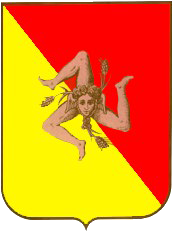
Well after months of anticipation and planning the vacation to Sicilia has come and gone. Its been a busy – at times maybe too busy – 16 days: food, wine, sights and sites. I'm not sure how many kilometres were clocked up on the car but its probably more in that two weeks than have been put on it in four years in Italy. And I'm not sure that even driving in Mexico City, Cairo and Roma had prepared Laurent for the singular style of driving that we encountered in the towns and road of Sicilia. Ah well we're in one piece which says more about him than it does the local drivers. One thing: I wouldn't have wanted to do it without the help of a GPS – that smarmy British voice telling us to “bear left” may be irritating at times but damned he knows the roads – or a least the ones that haven't been changed and not updated. Note to TomTom – there's an entirely new subdivision on the main road in Gela that nobody told you about!
 |
| The overnight crossing (12 hours) from Civittavechia to Palermo was smooth sailing however the good ship Splendid was not - splendid I mean. Grandi Navi Veloci should either update their website or their fleet. |
The first and last legs of the trip were on car ferries – Roma to Palermo/Catania to Napoli. The Grandi NaviVeloci to Sicily was, to put it kindly, an interesting experience. Shabby would be too polite a word. Let's just say that the boat had seen better days and I was afraid of walking barefoot on the carpeting. The TTT ferry back from Catania to Napoli, though smaller, was clean, cabin at the bow spacious and staff helpful - too bad they don't do the Civettavecchia to Palermo run.
 |
| The first part of our travels took us from Palermo along the Tyrrhenian Sea to the West and than eastward along the Mediterranean Coast. |
Laurent has written extensively
on his blog about the various stops on the itinerary and I'll be posting a few items on thing that caught my fancy as we travelled from Palermo to Trapani, Erice, Marsala, Mazara del Vallo, Agrigento, Ragusa, Siracusa, Noto and Catania. Looking at that list – and a general sense of fatigue at the end of the trip – make me aware that this is a trip that should have broken into two trips; in fact I said only the other day that had we been wise we would have spent a week in a different area of Sicily each year that we were here. But should, would and could are all conditional verbs – and in this case conditional past – so no point in labouring over what we should have done; just sit back and enjoy the memories of what we did.
 |
| Continuing on from Agrigento we headed a bit inland to Ragusa and then back eastward to the Ionian coast and the two major seas ports of Siracusa and Catania. |
And the memories are varied. Wonderful music - an emotionally charged performance of A Greek Passion in Palermo; wonderful food - an unexpected lobster fest at a local trattoria in Marsala were the room was filled with groups of men sharing a meal with their friends and only three women in the whole place and no it wasn't a gay restaurant; great wine - quite a few Enoteche but particularly Michelle's in Trapani and Salvatore's in Marsala; over the top baroque churches - the Duomi in Mazara del Vallo takes the prize with Ragusa running a close second; antiquities galore - the Valley of the Temple leading the pack; and friendly, warm, welcoming, if at times slightly suspicious of strangers, people.
 |
| The departure from Catania and the trip up to the Straits of Messina on TTT's Partenope was a bit on the rough side but once into the Tyrrhenian it was a smooth sail up to Napoli and then on to Roma by road. |
The one thing that struck me the first time I went to Palermo and was confirmed on this trip as I saw more of the island is that Sicily may be part of Italy but it isn't really Italian. It shares a common language and some history but the people, the food, the landscape has been molded by the influences of the Mediterranean in a way that makes it a place unto itself. A succession of occupiers - the Greeks, the Phoenicians, the Carthaginians, the Romans, the Byzantines, the Arabs, the Normans, the French and the Spanish - have left their mark. As it always is Nature has been both kind and cruel: the sea, earthquakes and volcanoes have formed, enriched and scarred the terrain making it both welcoming and hostile. Religion – Pagan and Christian – has molded the architecture of cities and minds. And a wry sense of survival on the part of the inhabitants has taken all these things – the good and the bad - and created a place that is Sicilia.
24 maggio - Santa Maria Ausiliatrice





2 comments:
Sounds like a wonderful trip!
I'm so jealous.
Post a Comment